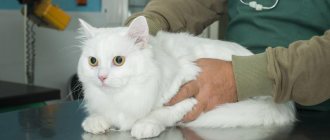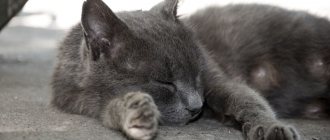Believe me, every owner will share your excitement. Just the thought that your pet is sick, but cannot say anything, can drive you into panic. However, let's not make hasty conclusions and take things in order. Any doubtful point can be clarified, quickly and consistently. If your pet seems very anxious, weak or depressed, and you are unsure of your abilities, it is best to consult a doctor.
The thermoregulation of cats is much more flexible than that of humans; if a person feels a good increase in body temperature by 1 degree, then the cat does not experience any discomfort. A cold and wet nose means the cat is healthy, a dry and hot nose means the cat is sick. The same cliché applies to the ears and can be considered partially true. We will explain why partially below.
Features of cat ears
In animals, there is no muscle tissue or fat layer between the ear cartilage and the skin. Even in dark individuals you can see blood vessels.
A person acutely feels temperature changes of even one degree. In this connection, it can only seem that the pet has hot ears. However, in some cases, worries are justified.
In normal condition, a cat's ears are pale pinkish or white. If they turn red, this indicates increased intravenous pressure or fever.
What measures to take?
Once you have determined that there is still a problem, you need to solve it. The best way is to contact a veterinarian. But how can you help a friend if you can’t visit a doctor?
There are several useful tips to help stabilize your kitten's normal condition.
Nutrition
This factor greatly influences the quality and quantity of years allotted to the cat.
Therefore, if you see, along with elevated temperature, stool upset, vomiting or other symptoms associated with the gastrointestinal tract, then first of all you need to change your diet. It happens that even with overeating or undereating, the temperature of the nose and ears noticeably increases. Clever kittens can generally pick up and eat anything. Watch your pet, see how much he has eaten, what food benefits him and makes him calmer.
Perhaps you have introduced something new to your diet, in which case you will have to abandon the innovations. You can create an individual diet, but only together with a doctor.
Stress
Our mustachioed and striped friends are very conservative. Therefore, the slightest changes in the usual way of life can traumatize their psyche, which is why the animal can behave, at least strangely.
If your cat has become unusually aggressive or, on the contrary, lethargic and apathetic, does not want to play, but with the tenacity of a Spartan he shits in your favorite shoes, then perhaps the cat is very worried.
There are many factors that contribute to a cat’s increased irritability:
- change of decor in the house;
- the appearance of guests on its territory, both people and animals;
- travel or relocation;
- change of owner or prolonged absence.
Various noises can also cause stress in a cat, for example, the sounds of firecrackers or other pyrotechnics on holidays. What to do? Stabilize the psychological state. Here, you don’t need to panic yourself, since the animals feel it well, you just need to help them adapt and get used to the new environment.
Infections
Cats, especially at a young age, are very susceptible to all kinds of infectious and viral diseases. First of all, it is important to pay attention to the symptoms:
- refusal to eat and drink;
- dry, hot nose, as well as hot ears;
- peeling of the skin;
- the appearance of bald spots on the head and body of the animal;
- heat;
- blood in the urine, difficulty urinating or stopping completely.
Under such circumstances, the animal must be taken to a veterinarian. If the temperature is elevated, you can normalize it by using a cool towel dipped in water or wrapping ice in it. Another way is to wipe the paw pads every hour with a solution of 9% vinegar in water, in a ratio of 1:2.
Never give antipyretic drugs without a doctor's prescription!
Drinking plenty of water will help here; it is advisable to give the kitten water yourself, because he may, due to his weakness, refuse to drink, and this is very important. Veterinarians recommend echinacea - one drop per kilogram of weight. This tincture is also useful for its ability to fight various infections in the body.
Stress and its effect on ear temperature
It happens that a cat’s ears literally “burn.” This usually serves as a signal that the pet has experienced severe stress; someone or something might have frightened her. In this case, all the efforts of the owner of the purr should be aimed at calming the beauty, showing that she is not in danger, and paying maximum attention to her four-legged friend. In this case, the care and attention of the owner will be the best medicine for the beauty.
If your pet’s stress does not go away, you should consult a doctor. Perhaps the cat is going through some difficult event and needs help so that the animal can avoid depression and problems associated with this disease.
How to determine a cat's condition
Owners periodically check the pet's health. If the nose is wet, the ears do not burn, there are no other symptoms of the disease, there is no cause for concern.
The following clinical picture should cause alarm:
- the pet becomes passive and indifferent to everything;
- refuses food;
- nose dry and hot;
- the animal constantly wants to sleep, lethargic;
- there is diarrhea or constipation;
- the fur became dull and began to accumulate in lumps;
- vomit comes out.
If at least one of the symptoms is present, the cat's temperature should be taken. The rectal method is suitable for animals: the tip of the thermometer is lubricated with Vaseline and inserted into the anus 1-2 centimeters.
Normal values in degrees:
- 37-38: in adult males;
- 38-39: in kittens and pregnant individuals;
- 41.5: in hairless breeds (for example, Sphynxes).
If the temperature is higher than normal and there are other signs of illness, the help of a veterinarian is necessary. After examination, the doctor will make a diagnosis: a viral infection, injury or ear mites.
Normal temperature in cats
If a cat has hot not only ears, but also a nose, then there may be serious health problems.
- The cat's body fights a viral infection
- Various intestinal disorders
- Cold
- Ear mites (symptoms and treatment we discussed above)
- There are a lot of infectious diseases that occur hidden and can only be identified by a specialist.
- External and internal inflammatory processes
- The cat may be injured, but if the damage is internal, you will not be able to determine it yourself
How to determine if your pet is sick
The cat has become lethargic, stopped eating, does not go to the toilet (or tries but fails), sneezes, and has a depressed and apathetic state. By measuring the temperature, you can determine whether there are inflammatory processes in the animal’s body.
What to do?
If your pet's behavior has changed dramatically. Visit a veterinarian, or make a house call, if possible. Don't let your pet's condition take its course. Help him and he will be grateful to you.
What do we have to do?
Monitoring the condition of your pet after detecting alarming symptoms implies systemic control.
- Several times during the day you need to measure and record your body temperature.
- Notice exactly when the animal’s ears become hot (sleeping, eating, playing). Is this phenomenon temporary or permanent?
- Monitor your appetite. The drinking bowl should always be filled with clean water at room temperature.
- Analyze the cat’s activity, taking into account its temperament: refusal to play is not always caused by illness.
Important! If you find other alarming signs in a domestic cat along with hot ears, you cannot carry out medication treatment on your own. The consequences can be dire.
If the cat has cold ears
Just like hot, cold ears in a cat do not always indicate the presence of a disease. The absence of alarming changes in the cat’s behavior defines this factor as the norm. Most often, the reason for a decrease in body temperature lies in a lack of heat. The animal is trying to get closer to the radiator and get under the blanket. Hairless cats usually suffer from the cold. The owners equip them with insulated houses, cozy beds, and purchase special cat clothes.
Cat in a blanket
Prolonged or frequent occurrence of this condition may indicate the presence of:
- Heart diseases. The disease affects domesticated predators of advanced age, overweight, and suffering from shortness of breath. Pedigree cats with genetic abnormalities are also at risk.
- Dehydration due to food poisoning, accompanied by vomiting or diarrhea.
- Toxicosis during pregnancy.
- Consequences of surgery or injury.
The reasons listed above are an urgent reason to visit a doctor. Cold ears in a cat are sometimes a more dangerous symptom than hot ears. This is evidence of exhaustion of the body, a decrease in its ability to resist disease.
What to do: when to contact a veterinarian?
You should consult a doctor if, against the background of an ear symptom, the animal begins to sleep most of the time.
In cats, red ears are observed not only at elevated temperatures. Symptoms are also considered to be a lethargic, apathetic state, when the animal sleeps all the time, the color of the coat has changed, intestinal upset is noticeable, and occasionally vomiting. All these symptoms indicate the presence of viruses in the body, kidney stones, injuries, and infections. When an owner notices something is wrong with their own pet, it is recommended to seek help from a veterinarian.
It is not advisable to bring down the elevated temperature when the kitten is hot on your own. To alleviate the condition, you need to provide constant access to cool water and moisten the fur and skin with a damp towel.
When changing the food, you may notice reddened ears and paws, as this may be a consequence of a food allergy. For this reason, you need to take your cat to a veterinarian, who will examine the animal. Similar symptoms can also appear if the kitten has worms, then the paws also become hot. This is also considered a cause for concern.
Why do my ears get hot?
Owners are very worried when their pets get sick. After all, an animal cannot say what is bothering it. They touch his nose: it should be wet. Sometimes the temperature of the ears is also checked.
Norm
Hot ears occur not only when the cat is sick, but also:
- during sleep, when the organ is heated under the sun or from a battery;
- after long and stormy games;
- if the cat is nervous or overexcited;
- when the pet has been in a hot and stuffy place for a long time.
In these cases there is no cause for concern.
Pathology
If, after measuring the temperature, the column shows an excess of the permissible values, changes in the pet’s behavior are observed, it is most likely sick. There is no point in trying to treat it yourself. This can cause harm.
The cat needs to be shown to a veterinarian. Only he is able to determine the pathogenesis of the pathological condition and select the correct treatment regimen.
Natural causes
The ears of mammals are the part of the body through which heat exchange occurs. Thanks to this, the body does not overheat.
Therefore, hot ears can be a consequence of:
- physical activity of the animal, for example, regular play;
- hot weather outside;
- awakening from sleep;
- stress, which is quite normal.
Therefore, there is no need to fear for the health of the animal if hot ears are observed irregularly and only under the influence of the factors listed above.
When is this normal?
Illness is not always the reason why a cat has hot ears. A rise in temperature can be caused by completely understandable everyday circumstances:
- Activity during games.
- Condition after sleep, when the pet slept near a heating device or basked in the sun.
- Established hot weather in summer, stuffy room.
Playing kitten In these cases, there is no reason to worry - the body temperature, and, consequently, the ears will soon return to normal.
But if in doubt, measure the cat’s body temperature rectally. Attention! Normal values for a kitten are 39-39.6°, the norm for adult animals is 38-39°, for hybrid hairless breeds – 40-41°.
Manifestations of stress, fear, and excitement can also cause a cat’s temperature to rise and make his ears hot. It is necessary to examine the animal and determine the factor that caused this standing:
- Moving, separation from the owner.
- Fright (repair work).
- Noises and smells (presence of strangers in the house: noisy guests, festive events, increased attention from children).
- The appearance of a new animal in the apartment .
If it is impossible to eliminate the cause of anxiety, you should ensure that your small pet gets used to the current situation as quickly as possible. Frequent or prolonged exposure to stress can provoke depression, which turns into a serious illness.
Warm
Cats love to rest in warm places, especially near radiators. In such cases, the ears will be the first part of the body to heat up. The cat is also able to regulate its own temperature. Once the heat source gets too hot, the cat will go elsewhere and its ears will cool down automatically.
The only exception is direct sunlight. Cats are big fans of the sun, so you need to monitor their time outdoors. A cat that spends a lot of time in the sun is at risk of developing skin cancer.
It is safer to let your cat bask in the sun indoors. Let your cat snooze on the windowsill, soaking up the sun's rays through the protective layer of glass.
Mr. Cat recommends: how to bring down the temperature
Hyperthermia can occur in an animal at any time. It is not always possible to immediately go to a veterinary clinic. First aid can be provided at home.
If the mark on the thermometer exceeds normal values, the cat needs to drink a lot. At high temperatures, the pet usually refuses food, but is tormented by thirst. You need to make sure that there is always clean, warm water in the bowl.
Echinacea tincture helps with hyperthermia. It can reduce temperature, activate the immune system, and destroy pathogenic microorganisms. Before giving your cat any medicine, you need to make sure that the dosage is strictly followed. Astragalus can also be used instead of echinacea.
To strengthen the immune system so that the animal recovers faster, it is recommended to give it vitamin C. However, it can only be used after consulting a specialist.
We recommend reading the article about vitamin deficiency in cats, so you can understand whether your pet has vitamin deficiency and what exactly the problem is related to.
Treatment and prevention
So, you have noticed that your cat is drooling transparently, why it does not go away for a long time, and how to cure your pet - a veterinarian will answer all these questions for you after an examination or examination. Having determined the causes of hypersalivation and made an accurate diagnosis, the specialist will prescribe appropriate treatment or surgery.
But, as you know, every treatment begins with prevention. By observing the following safety measures when raising a pet, you can prevent or mitigate the symptoms of ptiliasm:
- Chemicals and medications that are harmful to health must be stored out of the reach of the cat;
- It is better to remove poisonous plants from the apartment or plant them in a separate locked room where the cat has no access;
- it is necessary to normalize the animal’s nutrition, preventing the appearance of bones and sharp particles in the feed;
- When treating fleas with medications, put a special bandage on your pet’s neck to prevent them from licking;
- follow the vaccination schedule against contagious and infectious diseases;
- undergo regular examinations at a veterinary clinic;
- Carry out a thorough examination of the oral cavity for various inflammations.
If you notice that your cat is salivating profusely, why this situation has arisen and how it can threaten your pet, your veterinarian will tell you during the initial examination. The main thing is not to let things take their course, since now you know that hypersalivation, along with other symptoms, can become a harbinger of terrible diseases.
Consequences of rising temperatures
Often, hot ears in a cat do not indicate significant health problems. After all, it is known that these animals are big fans of lying in the sun or sitting on a hot radiator.
A cat has a wet nose: why is it cold and what does it mean?
If after such a pastime you notice dryness and sweating of the ears and nose, you should not attribute everything to a disease. However, you need to know in what situations you need to run to a specialist.
The temperature may be high as a result of the following:
- infection;
- inflammation;
- gastrointestinal diseases;
- injury;
- bladder stones;
- ear mite
Important! Stress and anxiety are often the reason why a cat has a hot head. Active play increases the heart rate, causing the temperature to rise, causing a symptom that frightens owners.
Stress
Stress suffered by a cat, even in mild form, instantly causes the release of hormones, pulse and heart rate increase, and blood pressure increases. Blood moves faster through the vessels, and the ears become hot. This phenomenon is usually short-term in nature. After the animal calms down, everything returns to normal. Sometimes stress in cats can be prolonged, which negatively affects the general condition of the animal and its nervous system.
Stress can cause a cat's temperature to rise
Signs of long-term stress in cats:
- the animal often goes to the toilet, sometimes past the tray;
- the animal does not make contact with people and hides;
- the cat is not sleeping, but is intensely watching those around her;
- nervous tail twitching;
- wide open dry eyes, enlarged pupils;
- the animal often licks, scratches and yawns;
- the animal moves unusually on its paws (crawl).
Played for a long time
Long active play by an animal is an analogue of a stressful state in which hormones are activated, heart rate and blood pressure increase, and ear temperature increases. In this state, it is enough for the cat to calm down and rest for 20-30 minutes. The ear temperature returns to normal.
Otodectosis - clinical picture
Hot and wet ears of a pet indicate a tick or fungal infection. The nose may remain wet.
When infected with ear mites, an accumulation of brown discharge is observed in the shells. If measures are not taken in a timely manner, the pathological condition will cause the development of otodectosis.
The disease causes the following symptoms:
- itching in the ears;
- restless animal;
- attempts to scratch the ear from the inside (because of this, the cat damages the skin with its claws, which aggravates the condition);
- the pet constantly shakes its head;
- red watery discharge mixed with sulfur and dirt;
- hyperthermia.
With otodectosis, the pet does not allow its ears to be cleaned, becomes very nervous, and screams. Discharge from the sinks is accompanied by squelching sounds. If the listed symptoms occur, you cannot postpone contacting the veterinary clinic. The disease requires long-term and adequate treatment, which can only be selected by a qualified specialist.
Pathologies
When the elevated temperature persists, and along with it changes occur in the behavior and condition of the animal, you should immediately contact a specialist. The following diseases can cause hot ears in a cat:
Ear mites (Otodectosis)
Ears may be hot due to ear mite infestation. Changes in the cat's behavior appear:
Otodectosis in a cat
- anxiety or vice versa – weakness and depression;
- scratching the ear, head, muzzle with claws;
- frequent shaking of the head;
- aggressive reaction to attempts to examine the ears.
The smallest parasites settle in the warm and moist ear canals of the animal, feed on its blood, lymph, skin scales, and cause severe itching. The products of their vital activity accumulate inside the abalone. It looks like a dirty and greasy coating that causes yellow-brown lumps and grains to stick to the walls of the ear.
Symptoms of this disease in an animal: hot and red ears, dried purulent discharge and an unpleasant odor from the auricle. The danger of ear inflammation is that this disease can be either independent or a consequence of another, more secretly developing disease, and can cause complications.
Manifestation of the disease in a cat:
- head tilt, stiffness of movements;
- change in the position of ear cartilage;
- the ears constantly get wet, a squelching sound is heard when massaging;
- poor appetite;
- excessive apathy or irritability;
- scratching ears, head.
Poor appetite
Other diseases
If you find that your cat not only has hot ears, but also a hot and dry nose, this could be due to:
- infection;
- problem with the gastrointestinal tract;
- stones in the kidneys.
The doctor will make an accurate diagnosis by determining what triggered the disease: food poisoning, contact with a sick animal, a cold, hypothermia.
Sometimes the ears of your four-legged ward become hot due to overeating or undereating. In these cases, the animal becomes lethargic, weak, often vomits, and has diarrhea.
Surgical interventions, lambing, injuries
The cause of hot ears in a cat can be a postoperative (sterilization, castration) condition. Typically, such procedures do not cause complications, but the situation must be monitored.
An increase in body temperature after lambing signals puerperal fever. This condition is extremely serious and requires special attention. The development of a fever can lead to a stroke.
Abyssinian cat
Stress
Stress can increase the temperature of a cat's ears. It causes spontaneous hypertension in cats, that is, the cat’s heart begins to beat faster and blood rushes to the head. This will cause your ears to heat up.
Hypertension has other side effects, such as strain on the heart. Stress can also lead to kidney failure. Cats are easily stressed. You may be upsetting your cat without even realizing it.
It is very important that a stressed cat calm down, otherwise it will be in physical danger, especially in old age.











